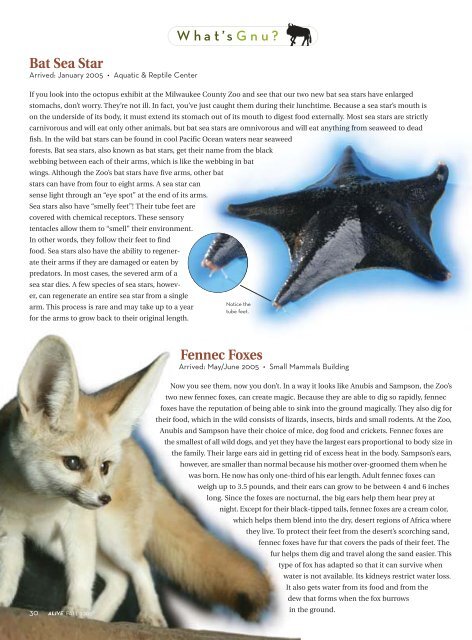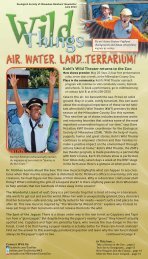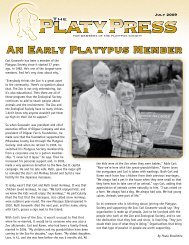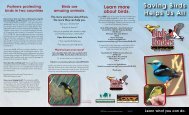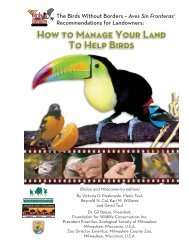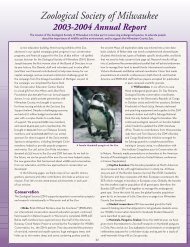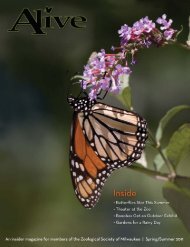AliveFall 2005 - Zoological Society of Milwaukee
AliveFall 2005 - Zoological Society of Milwaukee
AliveFall 2005 - Zoological Society of Milwaukee
You also want an ePaper? Increase the reach of your titles
YUMPU automatically turns print PDFs into web optimized ePapers that Google loves.
Bat Sea Star<br />
Arrived: January <strong>2005</strong> • Aquatic & Reptile Center<br />
What’sGnu?<br />
If you look into the octopus exhibit at the <strong>Milwaukee</strong> County Zoo and see that our two new bat sea stars have enlarged<br />
stomachs, don’t worry. They’re not ill. In fact, you’ve just caught them during their lunchtime. Because a sea star’s mouth is<br />
on the underside <strong>of</strong> its body, it must extend its stomach out <strong>of</strong> its mouth to digest food externally. Most sea stars are strictly<br />
carnivorous and will eat only other animals, but bat sea stars are omnivorous and will eat anything from seaweed to dead<br />
fish. In the wild bat stars can be found in cool Pacific Ocean waters near seaweed<br />
forests. Bat sea stars, also known as bat stars, get their name from the black<br />
webbing between each <strong>of</strong> their arms, which is like the webbing in bat<br />
wings. Although the Zoo’s bat stars have five arms, other bat<br />
stars can have from four to eight arms. A sea star can<br />
sense light through an “eye spot” at the end <strong>of</strong> its arms.<br />
Sea stars also have “smelly feet”! Their tube feet are<br />
covered with chemical receptors. These sensory<br />
tentacles allow them to “smell” their environment.<br />
In other words, they follow their feet to find<br />
food. Sea stars also have the ability to regenerate<br />
their arms if they are damaged or eaten by<br />
predators. In most cases, the severed arm <strong>of</strong> a<br />
sea star dies. A few species <strong>of</strong> sea stars, however,<br />
can regenerate an entire sea star from a single<br />
Notice the<br />
arm. This process is rare and may take up to a year<br />
tube feet.<br />
for the arms to grow back to their original length.<br />
30 ALIVE FALL <strong>2005</strong><br />
Fennec Foxes<br />
Arrived: May/June <strong>2005</strong> • Small Mammals Building<br />
Now you see them, now you don’t. In a way it looks like Anubis and Sampson, the Zoo’s<br />
two new fennec foxes, can create magic. Because they are able to dig so rapidly, fennec<br />
foxes have the reputation <strong>of</strong> being able to sink into the ground magically. They also dig for<br />
their food, which in the wild consists <strong>of</strong> lizards, insects, birds and small rodents. At the Zoo,<br />
Anubis and Sampson have their choice <strong>of</strong> mice, dog food and crickets. Fennec foxes are<br />
the smallest <strong>of</strong> all wild dogs, and yet they have the largest ears proportional to body size in<br />
the family. Their large ears aid in getting rid <strong>of</strong> excess heat in the body. Sampson’s ears,<br />
however, are smaller than normal because his mother over-groomed them when he<br />
was born. He now has only one-third <strong>of</strong> his ear length. Adult fennec foxes can<br />
weigh up to 3.5 pounds, and their ears can grow to be between 4 and 6 inches<br />
long. Since the foxes are nocturnal, the big ears help them hear prey at<br />
night. Except for their black-tipped tails, fennec foxes are a cream color,<br />
which helps them blend into the dry, desert regions <strong>of</strong> Africa where<br />
they live. To protect their feet from the desert’s scorching sand,<br />
fennec foxes have fur that covers the pads <strong>of</strong> their feet. The<br />
fur helps them dig and travel along the sand easier. This<br />
type <strong>of</strong> fox has adapted so that it can survive when<br />
water is not available. Its kidneys restrict water loss.<br />
It also gets water from its food and from the<br />
dew that forms when the fox burrows<br />
in the ground.


